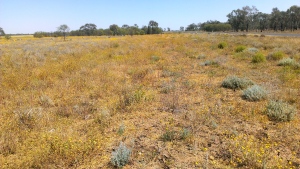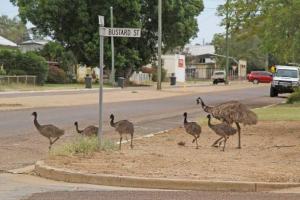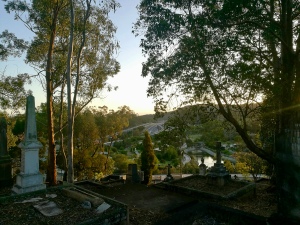Toowong Cemetery is a miniature of Brisbane’s inner suburbs. It has main roads and side streets, steep hills, valleys, outlooks, hoop pines and fig trees, butcher birds and lorikeets. Wealthier citizens inhabit the hilltops, and the humbler spill down into the gullies. There are elaborate memorials, and neglected graves covered in cobblers’ pegs.

Many of the family names on the gravestone are from the colonial past. This place is a history book of Brisbane.
It’s spooky after dark. I walked through with friends one evening at dusk, and I wouldn’t want to be there alone. Strange people lurk in Toowong Cemetery.
There is quite a lot of my DNA buried here, but I have ancestors in graveyards outside Brisbane, too. A few years ago, my cousin Nadine and I went on a ten-day, ten-cemetery family history road trip to find them.
Nadine researched the names and burial places of family members in the cemeteries of Warwick, Texas, Dirranbandi, Saint George, Mitchell, Barcaldine, Longreach, Roma, Dalby and Toowoomba: a three thousand kilometre loop by road. She is fascinated by family history, and I’m always happy to take a road trip, looking for stories along the way.
So off we go. Most of the graves we visit are of people we never knew: great-great-grandparents, great uncles and aunts and distant cousins. Some, though, are of our own generation.

At Dirranbandi, we stop and ask for directions to the cemetery. It’s along the river, on the outskirts of town. Crows croak, the ground is dusty, and at the gate a woman on her way out warns us there are lots of burrs in there.
Our little cousins, Peter and Judith, have been lying next to each other for over half a century in this sad, hot, dry place, in this hard countryside. Peter died of peritonitis, aged four, and Judith a few years later, aged five, drowned in the river. The bush can be cruel.

We pick bottlebrush from the cemetery’s few shrubs to place on their graves; and back in the car we pick burrs out of our clothes and shoes and skin.
Our seventh cemetery is Longreach. As we drive there from Barcaldine, the sides of the road look like The Somme after a battle, with bodies lying everywhere – the bodies of kangaroos, hit by vehicles.
I drive, and Nadine looks at the map.
“The cemetery is in Raven Road. Go past Thrush Road and turn into Lark Street. If we get to Falcon Street, we’ve gone too far. What’s with these street names?”
“All the streets in Longreach are named after birds. The water birds run east-west and the land birds run north-south.”
“Well, that doesn’t work. There’s a Sparrow Street running east-west. And here’s a Crane Street, running north-south!”

“I don’t know. Just so long as we can find Raven Road, and the cemetery. We don’t want to drive all over town searching for it, like we did in Dirranbandi…”
In the cemetery we tread carefully. The dusty soil is falling away, leaving cracks in the ground around the graves, and it would be easy to misstep and sprain an ankle. The ground is so dry it’s shrinking.
There is a smell of death in the air. It’s probably a dead kangaroo nearby; but disconcerting, in a cemetery.
We find a distant uncle’s grave. It is marked by a substantial block of sandstone, crafted by the well-known A.L.Petrie Monumental Sculptors, of Brisbane. A stone like this must have been expensive to bring out here, over a thousand kilometres from Brisbane. The inscription indicates that it was placed here by his friends and admirers; but days earlier we’d found his own mother’s grave in Roma Cemetery, with no marker on it at all.
Mysteries of the past.
Last time I was in this cemetery, twenty years ago, Con and I were looking for the grave of Leonard Pitkin. Con’s mother Min had been married twice, the first time to Len, and it was his grave we trying to locate. A phone call to the local council had provided us with the grave number, and we eventually found the spot; but there was no name on the grave, no headstone.
Len and Min had moved out here in the early 1920s, looking for work, and in 1923 he died here of typhoid fever. Min was pregnant, and her father made the long journey by train from Mackay to take her home.
There are many unmarked graves in the cemeteries of western Queensland. In the early days, people worked hard, far from their homes, building roads and railways and wrangling stock, or cooking over open fires while wearing long dresses. Life was primitive, and accidents and illnesses were common. Many graves here are marked only by a rusted steel number peg and a sprinkling of red gravel.

We’d sent a photo of Len’s grave to his daughter Joy, Con’s elder sister. She’d never seen her father’s burial place. She arranged for a headstone and came out on the train to place flowers on the spot where her father had been lying unacknowledged for over sixty years.
A few days after our Longreach visit, Nadine and I are at the Drayton and Toowoomba Cemetery. Founded in 1850 and heritage listed, it’s one of the oldest cemeteries in Queensland, built to hold forty-five thousand graves. This cemetery, unlike the others we’ve visited, has avenues with of tall trees, mossy or lichen-covered: kauri and hoop pine, London plane trees, camphor laurels and eucalypts.

Lichen makes the inscriptions hard to read. No lichen in Dirranbandi or Longreach. We find the headstone of a distant cousin we never knew, take photos, and move on.
Our last graveyard of the long trip is the Toowoomba Garden Cemetery. The grave we visit is fresh, the red earth bare and the headstone newly planted. This is where our cousin David had been buried just three months earlier, after losing his battle with cancer. David was the brother of little Peter and Judith. This was someone we had known and loved. This wasn’t family history research. This was personal.
So many cemeteries we’ve visited on this long trip, and this would be the last. And the saddest.
When I’m planted in Queensland earth, I’d like it to be in Brisbane’s Mount Gravatt Cemetery. It’s a serene place with gum trees and lots of bird calls – like a country town cemetery, but greener; with pale headed rosellas and king parrots, magpies and kookaburras. And no burrs.


Very touching, Rose – you are my favourite historian. I may yet learn a bit of history thanks to your efforts, patience and talent. Ian
LikeLiked by 1 person
Thank you, Ian.
LikeLike
I would like to do a guided tour of Toowong cemetery one day. I’ve heard they are very interesting. Your road trip was a lovely way to pay your respects.
LikeLike
It was a great road trip I did with my cousin. We got to know each other, as well as the cemeteries! I’ve written another couple of posts about it if you’re interested: Major Mitchelling, and Barcaldine. Cheers, Rose
LikeLike
Thanks. I’ll check them out.
LikeLike
I really enjoyed reading this post. Toowong Cemetery is one of my favourite strolls. A more meaningful visit for me is to Brookfield Cemetery, Brisbane, where I have family forever resting. It was a shame when Brisbane City Council closed certain cemeteries for awhile, there is an historical gap between Brookfield pioneers and the present day. I have noticed that retrospective plaques are appearing so maybe the generations will be re-joined.
LikeLiked by 1 person
I don’t know anything about Brookfield Cemetery. Might have to take a drive out there.
LikeLiked by 1 person
Small yet pretty 😉
LikeLiked by 1 person